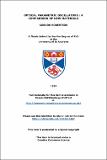Files in this item
Optical parametric oscillators : a comparison of new materials
Item metadata
| dc.contributor.advisor | Dunn, Malcolm H. | |
| dc.contributor.author | Robertson, Gordon | |
| dc.coverage.spatial | 218 | en_US |
| dc.date.accessioned | 2015-04-15T16:00:21Z | |
| dc.date.available | 2015-04-15T16:00:21Z | |
| dc.date.issued | 1993 | |
| dc.identifier | uk.bl.ethos.606831 | |
| dc.identifier.uri | https://hdl.handle.net/10023/6487 | |
| dc.description.abstract | A study of new materials for optical parametric oscillators (OPOs) was carried out using an XeCI excimer laser as a pump source. The three non-linear optical materials studied were lithium borate (LBO), deuterated L-arginine phosphate (d-LAP) and β-barium borate (BBO). These optical parametric oscillators were characterised for oscillation thresholds, tuning ranges, linewidths and efficiencies. A novel device in LBO was demonstrated, using the non-critically phase matched type II geometry. The device displayed a low oscillation threshold, which was independent of pump beam area thus made it attractive for use with low energy pump sources. The device was also shown to have a narrow inherent linewidth, oscillating on only one or two axial modes. Other geometries in LBO were also explored. The type I critical geometry displayed a very large tuning range covering the near ultra-violet, the visible and the near infra-red spectral regions. The type IT yz geometry was also studied. An OPO in d-LAP was demonstrated for the first time. The device was tunable in the blue/green spectral region and also in the near infra-red. A low threshold was observed for large beam sizes. Optically induced damage caused by the ultra-violet pump was also encountered. A comparison of the thresholds, efficiencies and tuning ranges of the three materials, LBO, d-LAP and BBO, was made and the suitability of each material for use in a line-narrowed oscillator discussed. Although possessing the largest linewidth, BBO was found to be the best suited due to its low oscillation threshold and large tunability. A single axial mode BBO OPO was demonstrated that was tunable from 385 nm to 560 nm and from 2300 nm to 684 nm. The line-narrowed OPO was then used for linewidth control of other devices. Firstly, an injection seeded OPO was demonstrated and the device was characterised for threshold and linewidth. Secondly, the line-narrowed OPO was used to seed an optical parametric amplifier (OPA). Single pass gains of ~20 were observed from the OPA. | en_US |
| dc.language.iso | en | en_US |
| dc.publisher | University of St Andrews | |
| dc.rights | Creative Commons Attribution-NonCommercial-NoDerivatives 4.0 International | |
| dc.rights.uri | http://creativecommons.org/licenses/by-nc-nd/4.0/ | |
| dc.subject.lcc | TK7872.O7R7 | |
| dc.title | Optical parametric oscillators : a comparison of new materials | en_US |
| dc.type | Thesis | en_US |
| dc.type.qualificationlevel | Doctoral | en_US |
| dc.type.qualificationname | PhD Doctor of Philosophy | en_US |
| dc.publisher.institution | The University of St Andrews | en_US |
This item appears in the following Collection(s)
Except where otherwise noted within the work, this item's licence for re-use is described as Creative Commons Attribution-NonCommercial-NoDerivatives 4.0 International
Items in the St Andrews Research Repository are protected by copyright, with all rights reserved, unless otherwise indicated.


